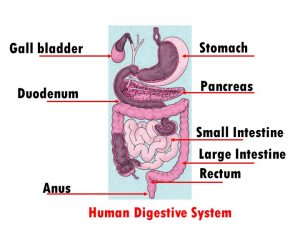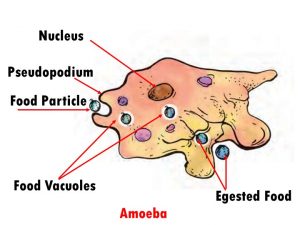Nutrition in Animals
Exercise:
1). Fill in the blanks:
(a) The main steps of nutrition in humans are ingestion, digestion, absorption, assimilation and egestion.
(b) The largest gland in the human body is the liver.
(c) The stomach releases hydrochloric acid and digestive juices which act on food.
(d) The inner wall of the small intestine has many finger-like outgrowths called villi.
(e) Amoeba digests its food in the food vacuole.
2). Mark ‘T’ if the statement is true and ‘F’ if it is false:
(a) Digestion of starch starts in the stomach. (T/F)
F
(b) The tongue helps in mixing food with saliva. (T/F)
T
(c) The gall bladder temporarily stores bile. (T/F)
T
(d) The ruminants bring back swallowed grass into their mouth and chew it for some time. (T/F)
T
3). Tick (√) mark the correct answer in each of the following:
(a) Fat is completely digested in the
(i) stomach (ii) mouth (iii) small intestine (iv) large intestine
(b) Water from the undigested food is absorbed mainly in the
(i) stomach (ii) food pipe (iii) small intestine (iv) large intestine
4). Match the items of Column I with those given in Column II:
Column I Column II
Food components Product(s) of digestion
Carbohydrates Fatty acids and glycerol
Proteins Sugar
Fats Amino acids
Answers:
Food components Product(s) of digestion
Carbohydrates Sugar
Proteins Amino acids
Fats Fatty acids and glycerol
5). What are villi? What is their location and function?
The inner walls of the small intestine have thousands of finger-like outgrowths. These are called villi.
Location: inner walls of the intestine.
Function: The villi increase the surface area for absorption of the digested food.
6). Where is the bile produced? Which component of the food does it help to digest?
Bile is produced in the liver. The bile plays an important role in the digestion of fats.
7). Name the type of carbohydrate that can be digested by ruminants but not by humans. Give the reason also.
Cellulose is the carbohydrate that can be digested by ruminants but not by humans. Ruminants have a large sac-like structure called Caecum between the oesophagus and the small intestine. The cellulose of the food is digested here by the action of certain bacteria which are not present in humans.
8). Why do we get instant energy from glucose?
Glucose can easily breakdown easily in the cell with the help of oxygen and gives carbon dioxide, water and energy.
9). Which part of the digestive canal is involved in:
(i) absorption of food small intestine.
(ii) chewing of food: mouth.
(iii) killing of bacteria: stomach.
(iv) complete digestion of food: small intestine.
(v) formation of faeces: large intestine.
10). Write one similarity and one difference between the nutrition in amoeba and human beings.
similarity
| Amoeba | Human beings |
| Digestive juices are secreted into the
food vacuole. They act on the food and break it down into simpler substances |
The inner walls of stomach and small intestine secretes digestive juices. These juices convert complex substances of food into simpler substances. |
difference
| Amoeba | Human beings |
| Amoeba feeds on some microscopic
organisms. When it senses food, it pushes out pseudopodia around the food particle and engulfs it. The food becomes trapped in a food vacuole |
Human beings take food through mouth. The food gradually gets digested as it travels through different components of digestive system. |
11). Match the items of Column I with suitable items in Column II
Column I Column II
(a) Salivary gland (i) Bile juice secretion
(b) Stomach (ii) Storage of undigested food
(c) Liver (iii) Saliva secretion
(d) Rectum (iv) Acid release
(e) Small intestine (v) Digestion is completed
(f) Large intestine (vi) Absorption of water
(vii) Release of faeces
Answers:
Column I Column II
(a) Salivary gland – Saliva secretion
(b) Stomach – Acid release
(c) Liver – Bile juice secretion
(d) Rectum – Storage of undigested food
(e) Small intestine – Digestion is completed
(f) Large intestine – Release of faeces
12). Label Fig. 2.11 of the digestive system.

Additional Questions:
True or false
1). The food components gradually get digested as food travels through the various compartments.
True.
2). Our teeth vary in appearance and perform different functions.
True.
3). Many animals including humans cannot digest cellulose.
True.
4). The liver increases the surface area for absorption of the digested food.
False.
5). The large intestine is wider and shorter than the small intestine.
True
6). The basic process of digestion of food and release of energy is different in all animals.
False.
Fill in the blanks
1). Plants can prepare their own food by the process of photosynthesis.
2). Bees suck the nectar of the plants.
3). The swallowed food passes into the food pipe or oesophagus.
4). Large intestine is about 1.5 m long in length.
5). The grass is rich in cellulose, a type of carbohydrate.
6). The small intestine is highly coiled and is about 7.5 metres long.
Answer in short
1). Write the names of the components of the alimentary canal.
The alimentary canal can be divided into various compartments:
(1) the buccal cavity,
(2) food pipe or oesophagus,
(3) stomach,
(4) small intestine,
(5) large intestine ending in the rectum and
(6) the anus
2). What is the function of the saliva?
The saliva breaks down the starch into sugars.
3). Write the functions of the tongue?
We use our tongue for talking. Besides, it mixes saliva with the food during chewing and helps in swallowing food. We also taste food with our tongues.
4). Name the components of the alimentary canal?
The components of the alimentary canal are the buccal cavity, oesophagus, stomach, small intestine, large intestine and the anus.
5). Name the two sets of teeth.
The two sets of teeth are milk teeth and permanent teeth.
6). Write the names of different types of teeth.
The different types of teeth are molar, premolar, canine and incisor.
Define the following.
1). Digestion
The breakdown of complex components of food into simple substances is called digestion.
2). Ingestion
The process of taking the food into the body is called ingestion.
3). Absorption
The digested food passes into the blood vessels in the wall of the intestine. This process is called absorption.
4). Egestion
The removal of the faecal matter through the anus from time to time is called egestion.
Label the diagram of the digestive system in Amoeba.

Click here for the solutions of
6). Physical and Chemical Changes
7). Weather, Climate and Adaptations of Animals to Climate
8). Winds, Storms and Cyclones
11). Transportation in Animals and Plants
14). Electric Currents and its Effects
16). Water: A Precious Resource
![]()

